Kyphoplasty
These articles are for general information only and are not medical advice. Full Disclaimer. All articles are compliments of the AAOS
Description
Kyphoplasty is a minimally invasive spinal surgery procedure. It is used to treat painful progressive vertebral body collapse/fracture (VCFs). The VCFs may be caused by osteoporosis or the spread of tumors to the vertebral body.
Osteoporosis is the age-related softening of bones. It causes the building blocks of the spine to weaken and collapse. This results in severe pain and a progressive hunchback. Certain forms of cancer also weaken the bone and cause the same problems.
Kyphoplasty is not appropriate for:
- Patients with young, healthy bones or those who sustained a vertebral body fracture or collapse in a major accident
- Patients with spinal curvature such as scoliosis or kyphosis that is due to causes other than osteoporosis
- Patients who suffer from spinal stenosis or herniated discs with nerve or spinal cord compression and loss of neurological function not associated with a vertebral compression fracture
The kyphoplasty procedure involves the use of a balloon to restore the vertebral body height and shape. This is followed by bone cement to strengthen it. The procedure may be performed under intravenous sedation. The patient may need local anesthetic or general anesthetic. The patient lies face-down on the operating room table. Two X-ray machines are used to show the collapsed bones.
The surgeon makes two small (less than 3mm) incisions. He or she inserts a tube into the center of the vertebral body. Through this tube, balloons are placed in the center of the vertebral body. (See Figure 1.) Then the balloons are inflated. (See Figure 2.) This pushes the bone back toward its normal height and shape. It also helps create a cavity. The surgeon will fill the cavity with bone cement.
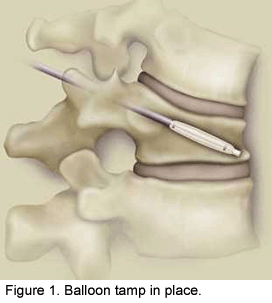
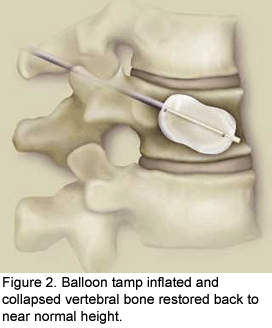
Once the cavity is created, the surgeon removes the inflatable balloon bone tamp. He or she mixes the cement and fills the cavity in a slow and controlled fashion. (See Figures 3 and 4.) The cement hardens. Then the surgeon takes out the tubes. He or she closes the incisions with a single stitch. Patients usually go home the same day. Patients can go back to all normal activities of daily living as soon as possible. They have no restrictions.
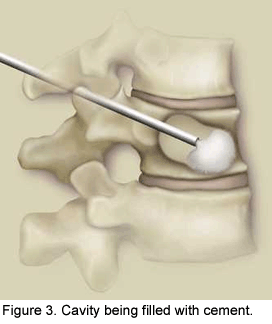
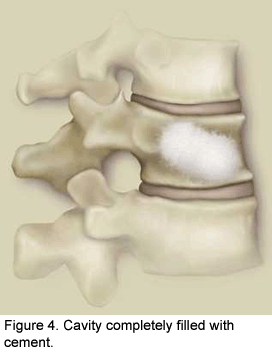
Early results show kyphoplasty is a safe and effective method of vertebral reconstruction and stabilization in the treatment of osteoporotic VCFs. Like all surgeries, kyphoplasty does have risks.
Complications may require additional treatments. These may be medications or surgery. Kyphoplasty is associated with excellent pain relief due to vertebral body collapse. Well over 95 percent of patients rate their treatment a success. They are able to return to all of their pre-VCF function. Patients typically do not need any form of physical therapy or rehabilitation after a kyphoplasty procedure. Because bone cement hardens within 15 minutes, there is really no healing that needs to happen from the patient’s standpoint.
Occasionally, patients complain of persistent pain after kyphoplasty. This may be due to irritation of tissues involved in the procedure itself. It is more likely due to underlying arthritis and degeneration of the spine.
- Pain due to the procedure will typically diminish within two weeks.
- If the pain is due to arthritic degenerative changes in the spine, the usual treatment is medications and an ongoing exercise program.
Restoring vertebral body height and size is best accomplished when kyphoplasty is performed soon after the VCFs happen. (See Figures 5 and 6.) After kyphoplasty, severe osteoporosis may cause other fractures at other levels in some patients. All patients must take bone-strengthening medications during treatment. If more vertebrae collapse, kyphoplasty can also be used at those other levels. Kyphoplasty has a tendency to help prevent more fractures. It keeps the spine lined up in its native upright position.

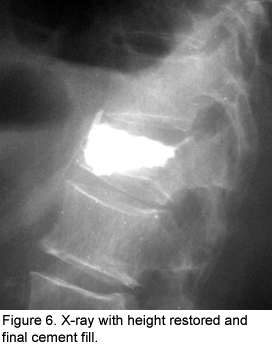
- The usual risks of local or general anesthetics apply. These risks depend on the patient’s overall health.
- There is a small risk of the bone cement leaking from within the boundaries of the vertebral body. In most cases, this rare event (occurrence less than 10 percent) does not cause any problems.
- In very rare circumstances the cement may irritate or damage the spinal cord or nerves. This can cause pain, altered sensation, or even, very rarely, paralysis (estimated risk is less than 1 in 10,000). Should the cement leak further, more significant surgery may be needed to stop the irritation of the nerves or spinal cord
- There is also a very small chance of the cement traveling to lungs. There is an even smaller chance of the cement block becoming infected at the time of surgery or even years later.
